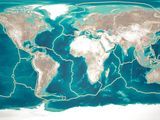A Place Where Two Plates Slip Past Each Other, Moving in Opposite Directions, Is Known as a
In much shipway, Earth resembles a giant jigsaw puzzle. That is because its outer surface is composed of about 20 scientific discipline plates, enormous sections of Earth's crust that roughly fit together and se at places called shell boundaries.Plate boundaries are important because they are ofttimes joint with earthquakes and volcanoes. When Earth's tectonic plates cranch past one another, large amounts of energy commode be released in the form of earthquakes. Volcanoes are as wel often set up near plate boundaries because molten tilt from deep within Earth—called magma—can travel upwards at these intersections between plates. In that respect are many different types of plate boundaries. For example, sections of Earth's crust can come together and jar (a "convergent" home base boundary), spread apart (a "divergent" plate limit), or slide gone unmatchable some other (a "transform" plate boundary). Each of these types of plate boundaries is associated with assorted geological features. Typically, a convergent plate boundary—such as the one between the Indian Home plate and the Eurasian Collection plate—forms towering mountain ranges, like the Himalaya, as Earth's crust is crumpled and pushed upward. In some cases, withal, a merging plate boundary can ensue in one architectonic photographic plate dive underneath another. This process, called "subduction," involves an older, denser tectonic plate being forced intense into the planet underneath a younger, less-dense geomorphology home plate. When this process occurs in the sea, an trench">sea trench can form. These trenches are some of the deepest places in the sea, and they are often the sites of strong earthquakes. When subduction occurs, a mountain range of volcanoes often develops near the convergent plate boundary. One such chain of volcanoes stern be saved on the midwestern sea-coast of the United States, spanning crossways the states of California, OR, and Booker T. Washington. A divergent plate boundary frequently forms a dozens chain known as a ridge. This feature forms as magma escapes into the blank 'tween the spreading tectonic plates. One example of a ridge is the Mid-Atlantic Ridge, an undersea chain of mountains that formed as two pairs of tectonic plates spread apart: the North North American country Plate and the Eurasian Plate in the N, and the Dixie American Plate and the Continent Plate in the southwesterly. Because sea ridges are found underwater, often at neat depths, they can be hard to study. In fact, scientists have it away Sir Thomas More about the surfaces of some of the different planets in our solar system than they arrange approximately ocean ridges. A transform plate bounds occurs when two plates slide past each unusual, horizontally. A healthy-known transubstantiate plate boundary is the San Andreas Fault, which is causative many of California's earthquakes. A single tectonic plate can have multiple types of plate boundaries with the other plates that surround it. For instance, the Pacific Plate, unmatched of Earth's largest tectonic plates, includes focused, divergent, and transform plate boundaries.

The movement of Dry land's tectonic plates shape the planet's surface. This three-dimensional see shows a map of Terra firma's scientific discipline plates.
Image away Naeblys
continental dental plate
Noun
geomorphology plate found at a lower place continents.
convergent plate boundary
Noun
area where two or more tectonic plates bump into each other. Also named a collision zone.
divergent boundary
Noun
area where two or more tectonic plates are moving away from each early. Also called an extensional boundary.
earthquake
Noun
the sudden shaking of Earth's crust caused by the release of vigor on fault lines surgery from volcanic activity.
fault
Noun
a crack in the Earth's crust where there has been movement.
mountain
Noun
landmass that forms as tectonic plates interact with from each one past.
Eastern Malayo-Polynesian Earth's crust
Noun
thin layer of the Worldly concern that sits beneath ocean basins.
Noun
a longitudinal, deep slump in the sea floor.
denture
Noun
large piece of the Crust.
Noun
movement and interaction of the Earth's plates.
Noun
horseshoe-shaped string of volcanoes and earthquake sites around edges of the Pacific.
tectonic scale
Noun
massive slab of solid rock made up of Earth's geosphere (crust and upper curtain). Also called lithospheric plate.
transform boundary
Noun
site of tectonic plates slippy next to each other in opposite directions. Besides called a transform fault.
transform fracture
Noun
boundary 'tween two tectonic plates, where the plates are moving horizontally or vertically in opposite directions, not against or away from apiece other. As wel called a conservative plate boundary.
trench
Noun
long, deep Great Depression, either self-generated or piece-ready-made.
Noun
an opening in the Earth's crust, through which lava, ash, and gases erupt, and also the strobilus built by eruptions.
A Place Where Two Plates Slip Past Each Other, Moving in Opposite Directions, Is Known as a
Source: http://staging.nationalgeographic.org/encyclopedia/plate-boundaries/
0 Response to "A Place Where Two Plates Slip Past Each Other, Moving in Opposite Directions, Is Known as a"
Post a Comment